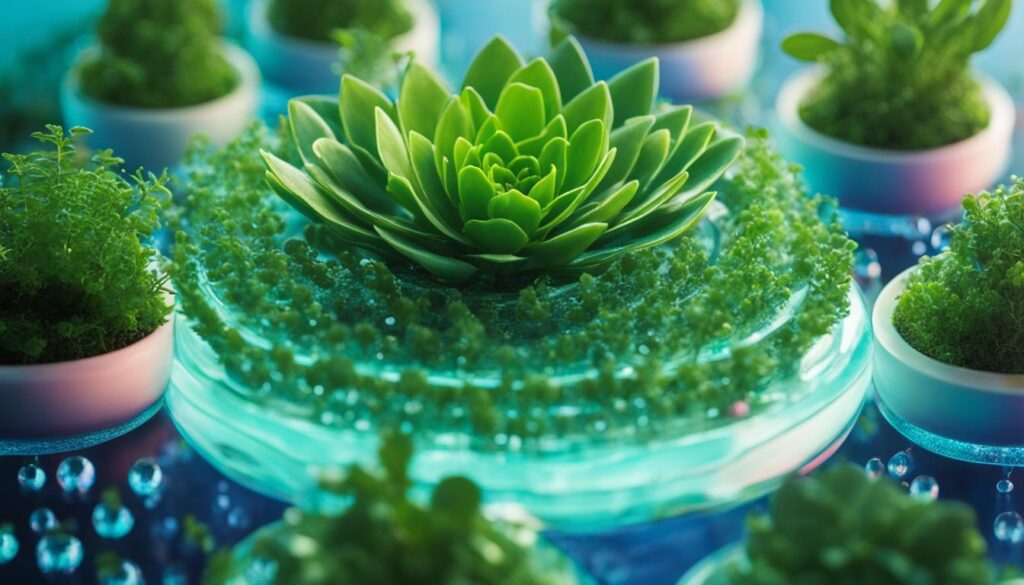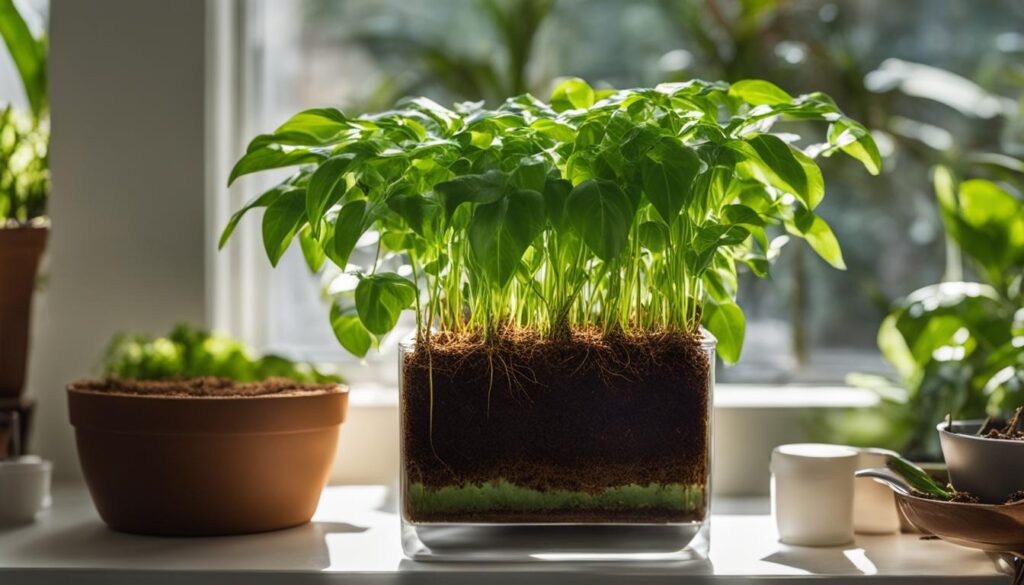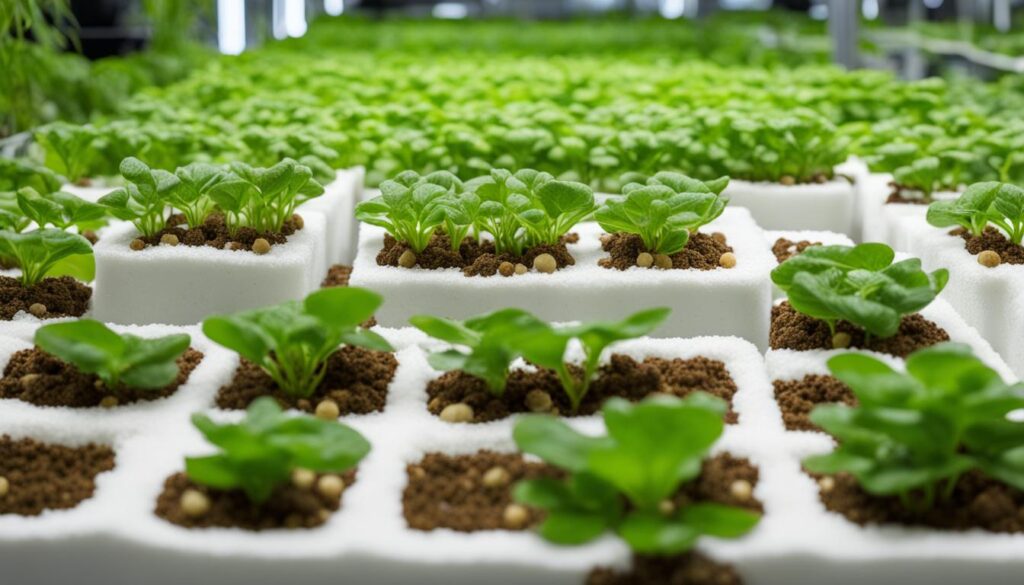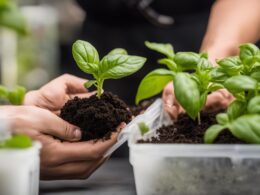Hydroponic gardening offers an innovative approach to soil-free cultivation by utilizing various hydroponic growing media that provide essential root support while effectively maintaining the water/oxygen ratio. The choice of growing media plays a substantial role in optimizing plant growth within hydroponic systems, influencing factors such as plant nutrition, aeration, and overall yield. In this article, we will explore some of the popular growing media, such as coco coir, expanded clay pellets, perlite, and growstones, which serve as alternatives to traditional soil and offer unique benefits that enhance plant growth in hydroponic gardens.
Key Takeaways
- Hydroponic growing media are essential for providing root support in soil-free cultivation systems.
- The choice of growing media impacts plant nutrition, aeration, and overall plant growth optimization.
- Coco coir, expanded clay pellets, perlite, and growstones are popular alternatives to traditional soil in hydroponic gardening.
- Each growing medium offers unique benefits for sustainable growing and optimizing plant growth performance.
- Consider factors such as water and oxygen balance, system compatibility, and environmental impact when choosing a hydroponic growing medium.
Understanding Hydroponic Growing Media
Choosing the right hydroponic media is paramount for optimizing plant growth and maintaining an efficient, eco-friendly system. When selecting a medium, essential factors to consider include plant support, aeration, nutrient supply, pH considerations, water retention, environmental impact, and renewable media. This section delves into significant aspects of hydroponic media and how they influence the success of your hydroponic garden.
Plant support and structural stability: An ideal growing medium should have a sturdy structure that offers adequate support to the plant and its roots. Supporting the root structure ultimately supports the plant’s overall health and growth.
Aeration: Proper aeration in the growing media provides oxygen supply to the root zone, helping plants breathe and process nutrients. Oxygen-rich environments contribute to preventing root diseases and promoting plant growth.
Nutrient supply: The growing medium plays a significant role in supplying plants with essential nutrients. Nutrient availability depends on the media’s ability to absorb and release nutrient-rich water, enabling the plants to take up nutrients effectively.
pH considerations: pH neutrality is crucial for ensuring nutrient uptake and preventing toxicity in plants. An ideal hydroponic growing medium maintains pH balance by reducing fluctuations.
Water retention: A hydroponic medium should have adequate water-holding capacity, enabling absorption and slow-release of the nutrient solution. This feature ensures that plants have constant access to water and nutrients, without drowning the roots.
Environmental impact and renewability: Choosing a sustainable and renewable growing medium not only benefits the plants but also contributes to environmental responsibility. Many hydroponic gardeners opt for eco-friendly materials that minimize waste and support a circular economy.
| Hydroponic Media | Support and Stability | Aeration | Nutrient Supply | pH Considerations | Water Retention | Environmental Impact |
|---|---|---|---|---|---|---|
| Rockwool | High | High | High | Neutral | High | Low |
| Expanded Clay | High | High | Medium | Neutral | Low | Medium |
| Coco Coir | Medium | High | High | Neutral | High | High |
Assessing the various characteristics of hydroponic growing media is essential for making informed decisions that suit your gardening needs. Evaluating factors such as lifespan, cost, and the potential environmental footprint of materials like rockwool, expanded clay, and coco coir can help you choose a hydroponic medium that meets your plants’ needs while maintaining an eco-friendly and efficient system.
The Benefits and Drawbacks of Coco Coir
Coco Coir, a sustainable hydroponic media, offers numerous advantages and a few disadvantages when used as an organic growth medium in hydroponic systems. Let’s explore the pros and cons of using this popular substrate.
Pros of Using Coco Coir in Hydroponics
- Water retention: Coco Coir’s excellent water retention properties allow it to hold up to 8 – 10 times its weight in water, leading to less frequent watering.
- Antifungal Properties: Coco Coir is known for its natural antifungal properties, inhibiting the growth of harmful fungi and bacteria within the growing system.
- Root Aeration: The fibrous structure of Coco Coir creates better root aeration, providing optimal oxygen levels for healthy root growth and overall plant health.
- Sustainability: Being a byproduct of the coconut industry, Coco Coir is a renewable resource, which appeals to environmentally conscious growers.
- Longevity: Coco Coir can last several years if disease management practices are in place, making it an economically viable choice.
Cons and Considerations of Coco Coir
- High salinity concerns: Due to its high sodium and potassium content, Coco Coir media must be thoroughly washed to remove excessive salts. Failure to do so can lead to plant damage.
- Sodium removal: Repeated washing is required to ensure the removal of sodium, which can be a time-consuming process.
- Hydroponic system compatibility: Coco Coir’s non-inert nature may not be suitable for all hydroponic system types and may require system modifications.
- Nutrient ratio adjustment: The use of Coco Coir typically requires specific nutrient ratio adjustments, particularly with potassium content, to optimize plant growth.
In conclusion, while Coco Coir offers several advantages as a sustainable hydroponic media, growers should be aware of its disadvantages and potential incompatibility with certain systems. By carefully evaluating these pros and cons and making appropriate adjustments, growers can optimize their hydroponic systems for improved plant health and yield.
Expanded Clay Pellets: A Popular Choice for Hydroponic Systems
Expanded Clay Pellets, known for their wide-ranging expanded clay pellets use in hydroponic systems, offer various advantages including their pH neutrality, structural stability, and reusability. These features contribute to making them an excellent hydroponic media selection for farmers interested in a pH neutral medium, striking a good oxygen-water balance, and reusing their growing media.
One of the significant reasons for the popularity of expanded clay pellets is their high porosity, which provides root support while ensuring proper aeration and water retention. This characteristic makes Expanded Clay Pellets especially suitable for ebb and flow systems and aquaponics setups.
Despite these benefits, growers need to be aware of several limitations when considering expanded clay pellets as a hydroponic growing medium:
- Poor water-holding capacity: Although these pellets offer ample aeration, they do not retain water as effectively as other media like coco coir.
- Drifting and potential clogging: Due to their lightweight and floating properties, expanded clay pellets can sometimes drift and clog certain hydroponic systems. Extra measures may be needed to prevent this issue.
- Root binding: Over time, plant roots can sometimes grow around or intertwine with the pellets, causing root disruption during harvesting or crop rotation.
- Initial financial investment: Expanded clay pellets can have a higher initial cost compared to other hydroponic media options on the market.
When considering expanded clay pellets for your hydroponic setup, it’s crucial to weigh these drawbacks against the aforementioned advantages to make the most informed decision. As a widely recognized reusable hydroponic media, expanded clay pellets provide a reliable and cost-effective choice for many hydroponic growers, despite some challenges.
Exploring Less Common Hydroponic Substrates
While coco coir and expanded clay pellets are popular choices for hydroponic growing media, there are alternative substrates available for those seeking unique advantages or environmentally-friendly options. In this section, we will explore perlite, rockwool, and growstones, their benefits and drawbacks, and examples of innovative applications in hydroponic systems.
The Pros and Cons of Using Perlite
Perlite in hydroponics is appreciated for its lightweight properties and impressive oxygen retention capabilities. The material fosters root aeration, supports ample oxygen levels, and can hold several times its weight in water. However, perlite has its fair share of drawbacks:
- Not typically used alone due to its tendency to float and wash away in some hydroponic systems.
- Handling perlite requires safety precautions to prevent inhalation and eye irritation.
- May not be suitable for all hydroponic setups.
Despite these disadvantages, perlite remains an attractive option in the right applications, offering a lightweight hydroponic medium boasting excellent oxygen retention and serving as a reusable growing medium.
Innovative Uses for Rockwool and Growstones
Rockwool, derived from spinning molten rock, is a common hydroponic medium credited with providing strong plant root support and excellent water retention. However, its use raises a few concerns:
- Potential environmental impacts due to its non-biodegradable nature.
- Can cause skin and respiratory irritation if not handled with care.
These drawbacks have led to innovative hydroponic innovation by way of alternative growing substrates, such as growstones. Growstones are made from recycled glass and provide a good air-to-water ratio, making them an attractive sustainable medium option. Nevertheless, growstones have their own unique set of challenges:
- Difficult to clean, which can present problems for reuse.
- Root adherence makes the medium difficult to separate from the plants.
Ultimately, each hydroponic substrate offers its own unique mix of advantages and disadvantages. Growers should carefully assess their specific needs and the potential risks and rewards of each material to select the best option for their hydroponic system.
Which Growing Medium is Best for Maximizing Plant Growth in Hydroponics?
Perlite and vermiculite hydroponics are two growing mediums commonly used in hydroponic systems. Perlite is lightweight and provides excellent aeration for plant roots, while vermiculite retains moisture and provides good drainage. The choice between the two depends on the specific needs of the plants being grown. Both perlite and vermiculite can contribute to maximizing plant growth by creating an optimal environment for root development and nutrient absorption in hydroponics.
Conclusion
Choosing the appropriate hydroponic medium goes beyond merely facilitating plant growth. It involves a comprehensive evaluation of factors such as environmental sustainability, operational efficiency, and economic realities for growers. A diverse array of options is available for hydroponic gardening, each presenting distinct advantages and disadvantages. As a result, growers must carefully assess the suitability of each medium in terms of supporting plant growth, nutrient management, and system compatibility.
With the continuous advancement of hydroponic technologies, innovative and eco-friendly growing media have emerged, such as Growstones and sustainable alternatives to Rockwool. As growers strive to enhance plant growth and productivity, they must also maintain a delicate balance between optimizing yields and reducing environmental impacts. By selecting the best hydroponic medium, you can ensure that your hydroponic system operates effectively and contributes to a more sustainable future.
As the world of hydroponic gardening continues to evolve, it is crucial to stay informed about the latest hydroponic advancements. By keeping abreast of new developments in growing media, production techniques, and sustainable practices, you can make informed decisions and maximize the potential of your hydroponic system. Ultimately, the success of your hydroponic garden relies on a combination of factors, including the careful selection of an appropriate growing medium that caters to both your plants’ needs and the broader environmental considerations.











